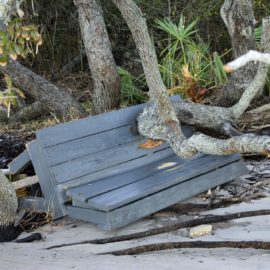
Thanks to climate change the estimated worst case damage from a major storm’s storm surge is now $5.5 B and that is from 1 major storm.
In just six years, cost estimates of the damage storm surge might do to Louisiana’s coastal communities have doubled, thanks to climate change and other factors, according to a new Coastal Protection and Restoration Authority study. The worst-case numbers, which measure what would happen if no additional mitigation efforts are pursued, estimate $5.5 billion in annual damage to those areas beginning in 2023, up from the $2.7 billion that was estimated in 2017. Data also show that flooding from surge waters created by a hurricane with a 1% chance of occurring in any year, the so-called 100-year storm, is expected to reach higher levels over the next 50 years, as global warming increases surge heights and storm intensities.
nola.com
These estimates were developed so that a priority could be determined on which projects should be first to be done as work begins.
The estimates were developed as starting points to use in determining which new projects should be included in the 2023 update of the state’s $50 billion, 50-year coastal restoration and hurricane risk reduction Master Plan, said Stuart Brown, who oversees the master plan rewrite for the authority. Coastal Authority Chairman Chip Kline was quick to point out to the authority’s board members Wednesday that officials already intend to add a variety of risk reduction projects to the plan that will drive down the potential damage totals. The master plan will then be presented to the state Legislature next year for approval. However, the estimates come after back-to-back years of nearly unprecedented damage totals, the result of both storm surge flooding and wind damage from hurricanes.
It has been a bad two years of hurricane damages, just ask the Lake Charles areas.
Tropical cyclone-related damage in Louisiana in 2020 totaled between $20 billion and $50 billion, according to the National Oceanic and Atmospheric Administration. That tally included the effects of Hurricanes Laura, Beta, Delta and Zeta. Damage from two storms in 2021 – Tropical Storm Claudette and Hurricane Ida – totaled between $50 billion and $100 billion. “Yeah, there will continue to be a fair amount of risk in living in coastal Louisiana,” Brown said. Brown said expected annual damages in 10 areas along the coast represented 50% of the 2023 worst-case total, with the towns of Slidell, Eden Isles and Pearl River leading the way with an estimated $845 million in annual damages. Fifth on that list is the $234 million a year potential damages for the communities of Mandeville, Covington, Madisonville, and Abita Springs.
There are mitigation projects planed for these areas in the coming years.
Projects already under study for those St. Tammany Parish communities, if added to the master plan, could significantly reduce those damages, however. The Army Corps of Engineers has proposed a $4.1 billion combination of risk-reduction projects in St. Tammany that could be submitted to Congress for authorization and potential future funding in early 2023. The tentatively selected plan includes building a 16.3-mile U-shaped combination of levees and floodwalls in the Slidell area and elevating more than 6,600 homes as much as 13 feet to meet future 100-year flood levels. It also includes floodproofing more than 1,850 nonresidential structures, and making drainage improvements along Bayou Patassat and Mile Branch. Meanwhile, the $294-million-a-year damages expected for Destrehan, New Sarpy and Norco might be reduced by a $1.2 billion Corps proposal to keep east bank New Orleans area hurricane levees elevated to 100-year levels between 2023 and 2073. Expected damages of $271 million a year for the Luling and Boutte communities might be reduced by a $1.6 billion Upper Barataria hurricane risk reduction levee, a project that is awaiting Congressional authorization and funding. The Morgan City and Berwick areas, which are predicted to see annual damages of $245 million, and New Iberia, which could see $156 million a year in damages, might have their damages reduced somewhat by the Corps’ proposed $1.3 billion South Central Coastal risk reduction project. That project recommends elevating 1,790 residences as much as 13 feet above the ground and floodproofing about 400 non-residential structures. The plan is still open for public comment before a final approval by Corps leadership; it must then be submitted to Congress for authorization and funding. And the Houma area is estimated to see $189 million a year in damages, but that number is expected to drop as additional segments of the Morganza to Gulf levee system are completed. The 2021 infrastructure bill included $379 million for the Corps for its 65% share of the $3 billion, 92-mile project. A portion of the $106 million a year in damages for the Larose area also is expected to be reduced by improvements to the Morganza levee system.

NATIONAL GEODETIC SURVEY PHOTO
While most of the areas will receive protection upgrades, there are some communities that may not.
Less clear, however, are chances for reducing the expected $165 million a year in damages for the Lafitte, Jean Lafitte and Barataria communities, which were devastated by Hurricane Ida’s surge in 2021. State officials have been lobbying the Corps to come up with a surge risk reduction plan, but at the moment, expected state-funded levee improvements in the area are limited to heights designed only to reduce flooding from a 50-year surge event. The $139 million in damage expected in communities in Vermilion Parish might be reduced by its inclusion in the Corps’ Southwest Coastal Louisiana hurricane risk reduction project, which also includes Calcasieu and Cameron parishes. The $1.5 billion project, already authorized by Congress, received $120 million from a 2022 infrastructure appropriation to elevate about 600 homes. Plans call for eventually elevating a total of 3,462 homes. The project also includes a number of coastal restoration features, some of which have already been completed. State officials point out that numerous coastal restoration projects, including the use of sediment moved by pipeline to create new wetlands in locations where they will provide additional protection to levees, also will help reduce surge heights over the next 50 years.
The model used to project the potential damage used many variables.
The model used to develop the authority’s risk estimates uses estimates of future damage to structures and their contents; non-structural assets, including roads, vehicles and crops; lost wages, sales and rents during repairs or reconstruction; displacement costs from temporary relocations; and debris and landscaping cleanup costs. To determine when and where those damages will occur, the authority uses a separate set of models that measures surge height plus waves and other flooding attributes. The surge models are calibrated by running “synthetic storms” that mimic tropical systems of varying sizes and intensities, ranging from those with a 20% chance of occurring in any year to those with only a 0.01% chance, often referred to as so-called 5-year to 1,000-year storms. Officials also use the models to show the water heights that would be created by a hurricane surge event with a 1% chance of occurring in any year, the so-called 100-year storm.

Coastal Protection and Restoration Authority)
The surge models have had many iterations as they try to do a better job of projecting the losses.
The surge models have gone through significant adjustments since they were last used for the 2017 master plan update, Brown said, including new information about changes in land heights and water depths along the coast. The modelers also increased the number of “synthetic storms” — storm simulations run at different angles and strengths at different locations along the coast to 645, compared to 446 synthetic storms used in the 2017 update. The modeling of “future without action” flooding risk and associated damages is used as a baseline in conducting a review of new projects, with each project plugged into models to see how well they reduce risk and at what cost. As the best projects are identified, they’re then dropped into the models in groups to determine how well they work together and what the final risk reduction will look like. Brown said those results should be available by September, in the form of similar maps of potential flooding over the next five decades and the expected risk reductions expected as the projects are completed. Formal public hearings on the Master Plan rewrite will be scheduled after its expected release in January 2023. A final version of the plan will be presented to the Legislature later that year.
This is a lot of money not helped by inflation of prices. But the influx of money this year will help.



